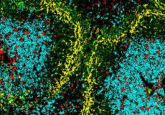Gray hair and your immune system

Feeling stressed or sick and going gray? Researchers have established a connection between genes responsible for hair color and the immune system.

Scientists at the NIH (MD, USA) and the University of Alabama (AL, USA) have discovered a connection between gray hair, innate immunity and the transcription factor MITF. The researchers, who published their findings in PLOS Biology, believe that this discovery could have future potential for developing treatment for graying hair and even skin diseases such as vitiligo.
The researchers were originally studying melanocyte stem cells that are responsible for producing melanocytes that make and deposit pigment into the hair. However, due to the power of the genomic tools that we have today, the scientists made a surprising discovery as author Melissa Harris explains,
“Genomic tools allow us to assess how all of the genes within our genome change their expression under different conditions, and sometimes they change in ways that we don’t anticipate. We are interested in genes that affect how our stem cells are maintained over time. We like to study gray hair because it’s an easy read-out of melanocyte stem cell dysfunction.”
This led the group to look into the transcription factor MITF, which has a known function of regulating melanocytes. However, the team also noticed that MITF controlled the melanocytes’ interferon response.
All cells have the ability to respond to invading pathogens in the body. Part of this innate response includes the generation of interferon by your cells. The interferon signals the body’s immune defences which can then fight the infection.
Co-author William Pavan explains the significance of this finding:
“This new discovery suggests that genes that control pigment in hair and skin also work to control the innate immune system. These results may enhance our understanding of hair graying. More importantly, discovering this connection will help us understand pigmentation diseases with innate immune system involvement like vitiligo.”
In the future the group hopes to determine the reasons for premature graying in humans with new studies, including looking at why mice that are prone to go gray prematurely are more likely to experience dysregulated immune signalling.





